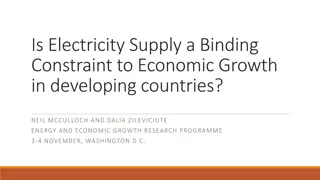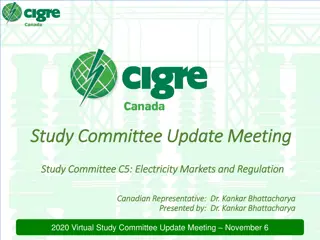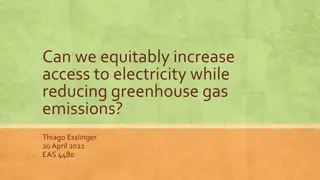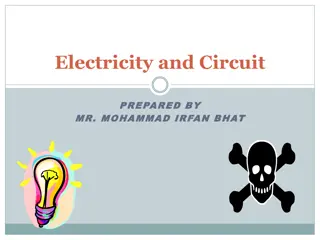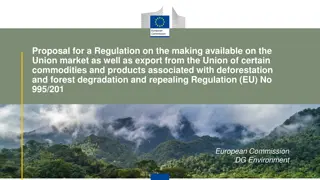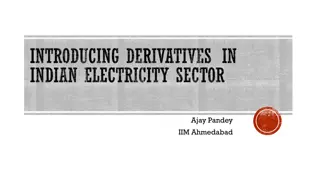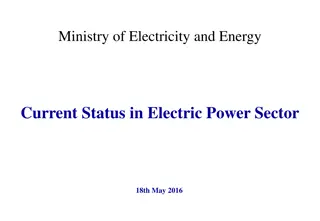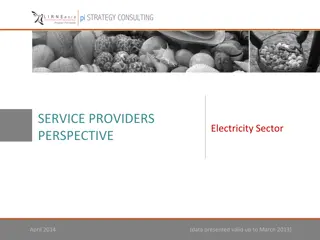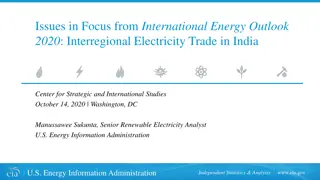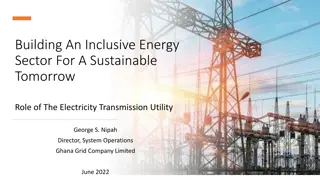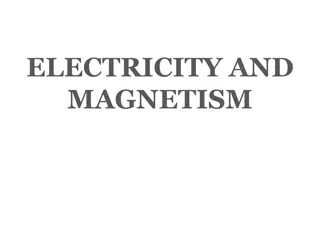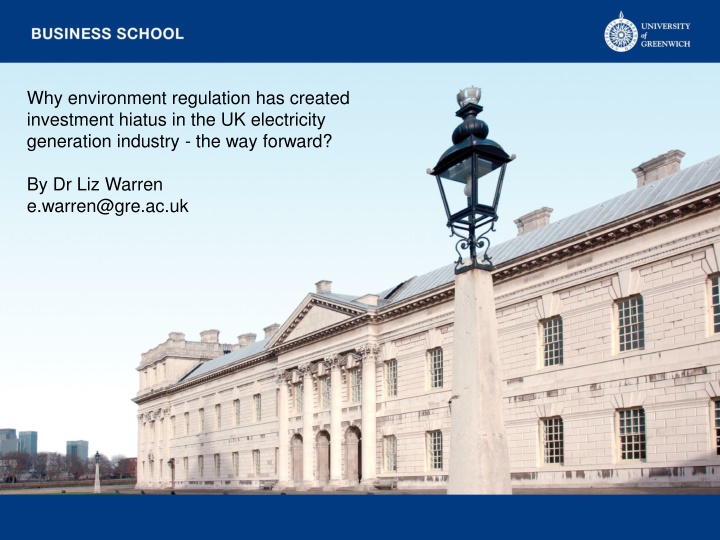
Impact of Environmental Regulation on UK Electricity Industry
This presentation by Dr. Liz Warren explores how environmental regulations since 2001 have impacted the UK electricity generation industry, leading to an investment hiatus. It discusses the background, regulations, competition, and the future outlook of the UK market in comparison to Canada. It also highlights private sector investment trends and the importance of renewable energy in the industry.
Download Presentation

Please find below an Image/Link to download the presentation.
The content on the website is provided AS IS for your information and personal use only. It may not be sold, licensed, or shared on other websites without obtaining consent from the author. If you encounter any issues during the download, it is possible that the publisher has removed the file from their server.
You are allowed to download the files provided on this website for personal or commercial use, subject to the condition that they are used lawfully. All files are the property of their respective owners.
The content on the website is provided AS IS for your information and personal use only. It may not be sold, licensed, or shared on other websites without obtaining consent from the author.
E N D
Presentation Transcript
Why environment regulation has created investment hiatus in the UK electricity generation industry - the way forward? By Dr Liz Warren e.warren@gre.ac.uk
Purpose of the presentation To examine the impact that targeted regulation has had on the UK electricity generation industry. To consider the future of the UK market. To briefly discuss the vast differences between the UK s problems and Canada s current predicaments.
Background to UK electricity generation industry 1990 privatisation, the aim was to stand back and let the market drive investment. 2001 Introduction of NETA (New Electricity Trading Arrangements), electricity was now traded as any other commodity. From 2001 there have been a significant number of environmental regulations introduced
Environmental regulation since 2001 Drivers Regulations Targets Global (Kyoto), EU (Various), UK (Climate change Act 2008) Emissions European Union Emission Trading Scheme (EUETS), Waste Incineration Directive (WID), Large Combustion Plant Directive (LCPD), UK National Emissions Reduction Plan (NERP), Industrial Emissions Directive (IED) EMR Contracts for difference (CfD) and Capacity Market. Energy Renewable obligations banding, Renewable obligations, Feed in Tariff (FiT) and Renewable Heat Incentive (RHI). Efficiency Climate Change Levy (CCL), Carbon Price Support (CPS), Green deal and Energy Companies Obligation (ECO), Carbon Reduction Commitment (CRC), Energy Efficiency Scheme, Building regulation, Code of sustainable homes (CSH).
Generation fuel portfolio 2000-2012 Source: Dukes, 2013
A brief indication of what has been happening in the past two years In 2012, private sector investment in the energy sector rose to 11.6b, representing about 10% of UK capital investment in 2012, or the equivalent to building 20 Olympic stadiums. This was more than private sector investment in transport or public investment in health or education. (E&Y, 2013)
A brief indication of what has been happening in the past two years Renewable energy is an important component of energy sector investment. Between January 2010 and April 2013, 29b in renewable investments was announced, expected to support 30,000 jobs. (E&Y, 2013)
A brief indication of what has been happening in the past two years Energy sector companies have proposed investing in enough additional combined cycle gas turbine (CCGT) plants and nuclear power stations to power 25 to30 million homes (27 gigawatts),11 over the next decade, but many projects are awaiting Government policy decisions before committing to construction. (E&Y, 2013)
So what? Source OFGEM, 2013
Whats the story? Investment Security of supply Regulation
Whats the story? Market led investment Increased regulation to encourage renewables yet no secure future policy No legal requirement to ensure security of supply
Typical investment 1000 MW investment (in a gas plant, CCGT) would cost approx. 600 million with a life expectancy of approx. 25 years -this would supply 800,000 households (Warren & Seal, 2014). Takes between 4-7 years to plan and get permit (section 36) These investments are to compete against renewables projects that have financial incentives. Too many uncertainties
Investment mix in the UK Targets: 15% renewables by 2020 (Pollitt & Haney, 2013) Going well due to financial incentives ROCS and in future CfD. However, the remaining 85% of the portfolio needs consideration.
What has regulation achieved? Transparent policy and regulation in the renewables sector has reduced uncertainty and increased investment in renewables (Mani & Dingra, 2013) UK is now the principal offshore wind market in the the EU. However, renewable regulation has created an overall uncompetitive energy market (Helm, 2014)
Real Options New Power - Gas (CCGTs) 4% Source: Plats New Power and respective developers. Cited in E&Y, 2013) 25% 71% Approved Suspended Under Construction
Real Options When the companies within the UK electricity generation industry use investment appraisal they have to add a large risk margin because expected future policy can impact on profitability, this is why the UK is finding it difficult to attract capital (White et al, 2013).
The future of the UK in this sector White paper (2011) accepts there is a need for change the government have finally accepted they can t leave this any longer to deal with if they don t blackouts are a significant possibility. Therefore they started the Energy Market Reform (EMR).
EMR will it work? Aims to target both renewables and non- renewables and provide more certainty to the market. CfD Contracts for Difference CPS Carbon price support CM Capacity market EPS Emissions performance standards
So what is the result in the UK Positive we are increasing the % of the portfolio relating to renewables. Although the UK public is questioning if this is an ideology we can currently afford! Negative investment hiatus has created a great strain on the system questioning security of supply for 2014-15.
So what is happening in Canada is it the same experience? Canada UK Country has an abundant and diverse set of resources Relies heavily on importing resources especially now with increased carbon targets Federal and provincial governments overseeing regulation National and super national governments overseeing regulation One of the largest energy exporters issues e.g. Fracking in the USA. Leading off shore wind market in Europe. 2nd Largest reserves of crude oil (mainly in Alberta), issues of expansion of pipelines e.g. Keystone XL
So what is happening in Canada is it the same experience? Canada UK Net exporter Net importer GDP contribution from the energy sector 6.8% (www.energy.ca) GDP contribution from the energy sector 3.5% (DECC, 2013) 16% total investment to the economy (www.energy.ca) 10.1% total investment to the economy (DECC, 2013)
Conclusion The UK has signed up for high targets to reduce emissions. Providing financial incentives for renewables but leaving the investment for the remaining market to be market led (but with no supporting policy on the future of the market). Theory and practice not considered ..politics V real options.
Bibliography As per chapter provided and: CAPP (2014) Commentary. www.capp.ca accessed 1st March 2014 DOS (2014_ New Keystone XL Pipeline Application. www.keystonepipeline-xl.state.gov accessed 1st March 2014 Dukes (2013) Digest of United Kingdoms energy Statistics 2013. https://www.gov.uk/government/publications/digest-of- united-kingdom-energy-statistics-dukes-2013-printed-version-excluding-cover-pages accessed 10th March 2014 Ofgem (2013) Electricity capacity assessment report 2013. https://www.ofgem.gov.uk/publications-and-updates/electricity- capacity-assessment-report-2013 accessed 10th March 2014 Ernst & Young (2013) Powering the UK. Energy Uk. www.energy-uk.org/energy-industry/powering-the-UK.html accessed 2nd March 2014 Fertal, C., Bahn, O., Vaillancourt, K. Waaub, J. (2013) Canadian energy and climate polices: A SWOT analysis in search of fedral / provincial coherence. Energy Policy. 63, pp 1139-1150 Murray, A. Interview. Director of Olefins Business Development at NOVA chemicals Canada.










